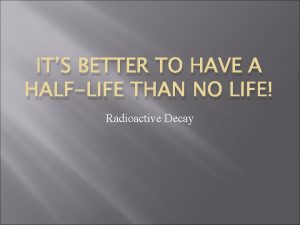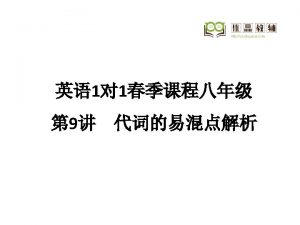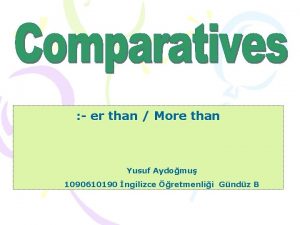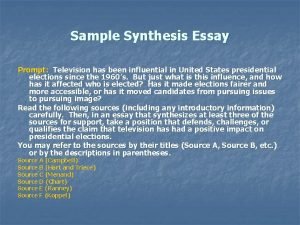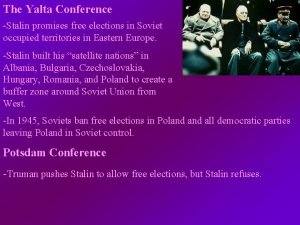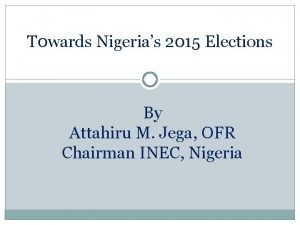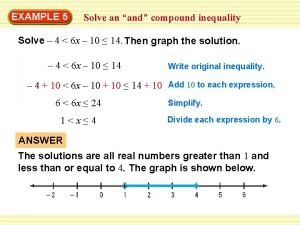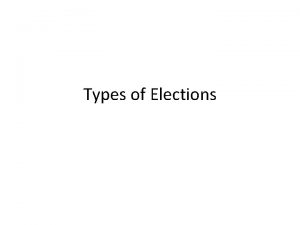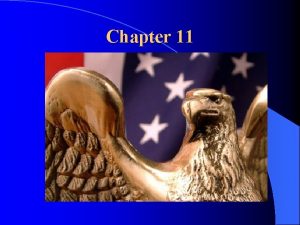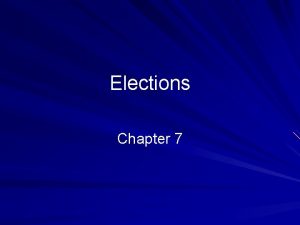MAT 105 Spring 2008 Elections with More Than
















- Slides: 16

MAT 105 Spring 2008 Elections with More Than Two Candidates

Two Candidates: Easy �As we have discussed, when there are only two candidates in an election, deciding the winner is easy �May’s Theorem states that majority rule is the “best” system

Three or More Candidates: Hard �However, the situation is much more tricky when there are more than two candidates �The system we typically use in the US is called plurality voting �Each voter casts a single vote for their top preference, and the candidate that gets more votes than any other is the winner

Flaws with Plurality � We have seen several historical examples that show flaws with the plurality system � One major flaw is that often the winner of an election is least-preferred by a majority of the voters (1912 Presidential, 1998 MN Gubernatorial) � Another flaw is the inability for voters to express their true preference: in 2000, many voters would have cast their ballots for Nader or Buchanan, but did not want to “throw away” their votes

A Better Way? �We would like to find a voting method that fixes these problems �Whenever there is a close or controversial election, there is an effort to try to reform or improve the system �This has occurred throughout democratic history, and many alternative systems have been developed

Marquis de Condorcet �A philosopher and mathematician, Condorcet was well aware of the flaws in the plurality system �Condorcet suggested a method based on the fact that majority rule works so well for two candidates

The Condorcet Method �Every voter fills out a ballot that lists his or her entire preference list �For example, a voter might have the preference D > A > C > B, which means he or she prefers D most, A second most, C third most, and B least �Remember, in a plurality election, this voter would only have been able to cast a single vote for D

Pairwise Elections �Once all of the ballots are submitted, we consider all of the different pairings of two candidates against one another �If there are three candidates, there are three pairings: A vs. B, A vs. C, and B vs. C �If there are four candidates, there are six pairings: AB, AC, AD, BC, BD, CD

Finding the Winner of a Pairwise Election �Using the preference ballots, we determine the winner of each pairwise election �Recall the voter who submitted the ballot with preference D > A > C > B �In the A vs. B election, this vote would count toward A’s total, since it lists A higher than B

An Example � � � Here we have listed some preferences together with the number of voters who have those preferences. Number of Voters Preference Order 6 Milk > Soda > Juice 5 Soda > Juice > Milk 4 Juice > Soda > Milk This is called a “voter profile” Now we compute the winner of each pairwise election: Milk Soda 6 Total: 6 Milk Juice 6 5 4 4 Total: 6 Juice 6 5 Total: 9 Soda Total: 9 5 4 Total: 11 Total: 4

The Condorcet Winner �Using this method, the winner is the candidate that wins all of the pairwise elections it is involved in �In our example, since Soda beat Milk and Soda beat Juice, Soda is the Condorcet winner �Polling data suggests that Al Gore would have been the Condorcet winner in the 2000 Presidential election in Florida

Advantages of the Condorcet Method �One big advantage of this method is that it allows voters to express their full preferences �In addition, the method relies on majority rule, which we know to be a “fair” system �However, the Condorcet method has a major flaw, which was known to Condorcet even as he was advocating its use

The “Condorcet Paradox” � Consider this voter profile, with three candidates and only three voters Number of Voters Preference Order 1 1 A>B>C B>C>A 1 C>A>B � Notice that there is no Condorcet winner A B 1 A 1 1 B 1 1 Total: 1 C 1 1 1 Total: 2 C Total: 2 1 Total: 2 Total: 1

Using Condorcet as a Guide �The major flaw of Condorcet’s method is that it sometimes doesn’t determine a winner �Imagine the chaos that would result if this occurred during a national election �However, if there is a Condorcet winner, it is natural to think that winner should be the winner of an election no matter what method is used

The Condorcet Winner Criterion (CWC) �We say that a voting method satisfies the “Condorcet Winner Criterion” if, whenever there is a Condorcet winner, this method determines the same winner �We know that plurality does not satisfy this criterion, since in Florida in 2000, Al Gore was the Condorcet winner, but not the plurality winner �Knowing that a voting method satisfies the CWC tells us that the method is “fair” in some sense

Another Example Number of Voters Preference Order � The plurality winner is A, but the 6 5 A>B>C>D B>D>A>C � Who should win this election? 3 1 D>B>A>C C>A>B>D � This example also shows that plurality doesn’t satisfy the CWC Condorcet winner is B A B 6 A D 6 B 5 5 5 3 3 8 14 1 1 7 8 B 6 5 1 C 6 5 1 7 C 14 D C 6 5 3 1 12 D 3 1 3 7 8
 Lirik lagu more more more we praise you
Lirik lagu more more more we praise you More more more i want more more more more we praise you
More more more i want more more more more we praise you 5730x5
5730x5 Greater than god more evil than the devil
Greater than god more evil than the devil Generous kelimesinin comparative hali
Generous kelimesinin comparative hali 2008 2008
2008 2008 Spring winter summer fall
Spring winter summer fall Spring summer fall winter and spring cast
Spring summer fall winter and spring cast Governing marriage laws and conducting elections
Governing marriage laws and conducting elections “elections are key to democracy”
“elections are key to democracy” Ap lang synthesis essay television presidential elections
Ap lang synthesis essay television presidential elections David becker elections
David becker elections Stalin promise free elections
Stalin promise free elections African charter on democracy, elections and governance
African charter on democracy, elections and governance Presidential elections exploration and announcement
Presidential elections exploration and announcement Conclusion on elections
Conclusion on elections Greater than less than examples
Greater than less than examples


